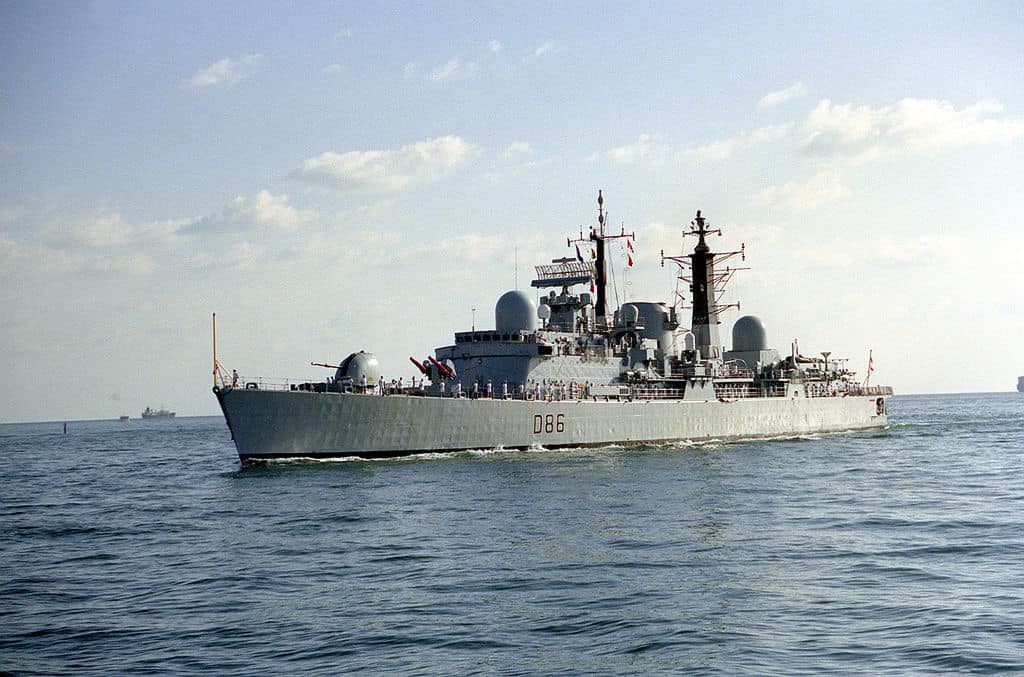
The Type 42 destroyer, also referred to as the Sheffield class, was introduced into the Royal Navy during the 1970s to meet the need for an advanced air defense warship. These vessels were designed as a more economical alternative to the larger Type 82 destroyers, which had been canceled. The Type 42 became a staple of British naval operations, with 14 ships built between 1972 and 1985. The class earned a prominent place in military history for its role in the Falklands War, where its air defense systems played a crucial role in protecting the British fleet.
Type-42 Destroyer Design
The Type 42 destroyer was designed to be compact and cost-effective while still providing advanced capabilities. Its sharp bow and distinctive lattice mast housed radar and sensor systems critical for its air defense mission. The hull was optimized for speed and maneuverability, though its smaller size created limitations, particularly regarding survivability and operational endurance during sustained engagements. The ships displaced around 4,800 tons at full load and measured 125 meters in length. Their primary role was fleet air defense, complemented by secondary capabilities such as anti-submarine warfare and general escort duties.
Features and Capabilities of the Type-42 Destroyer
The heart of the Type 42 destroyer’s combat power lay in its Sea Dart missile system, a medium-range surface-to-air missile designed to counter high-speed aerial threats. The twin-missile launcher, mounted on the forward deck, could engage targets at ranges exceeding 30 miles. This capability made the Type 42 a formidable asset for fleet protection against aircraft and missile attacks.
Radar and sensor systems were integral to the ship’s effectiveness. The Type 965 radar provided long-range air surveillance, while the Type 1022 radar facilitated target acquisition. These systems worked in concert with sonar, such as the Type 184, to provide anti-submarine detection capabilities.
For artillery support and close-in defense, the Type 42 destroyers were equipped with a 4.5-inch Mark 8 naval gun, capable of engaging surface targets and providing shore bombardment. Later units received upgrades like the Phalanx Close-In Weapon System (CIWS) to bolster self-defense against incoming missiles.
The ships were powered by a COGOG (Combined Gas or Gas) propulsion system, comprising two Rolls-Royce Olympus and two Rolls-Royce Tyne gas turbines. This configuration allowed speeds of up to 30 knots and a range of approximately 4,500 nautical miles at a cruising speed of 18 knots. A helicopter flight deck and hangar further enhanced the destroyers’ versatility, enabling operations with a Lynx or Sea King helicopter for anti-submarine warfare and search-and-rescue missions.
Type-42 Service History
The Type 42 destroyers served in a variety of roles, including NATO operations, multinational exercises, and active combat missions. Their most notable deployment was during the Falklands War in 1982, where they were tasked with defending the British fleet against Argentine aircraft. Tragically, HMS Sheffield, the lead ship of the class, was lost to an Exocet missile strike, underscoring the vulnerability of naval vessels in modern warfare.
Following the Falklands conflict, the Type 42 destroyers underwent a series of upgrades to enhance their combat capabilities, particularly in radar and missile systems. Despite their limitations, they remained a critical part of the Royal Navy’s fleet until they were gradually replaced by the more advanced Type 45 destroyers, with the last Type 42 decommissioned in 2013.
Fleet Table: Type 42 Destroyers
| Name | Pennant Number | Launch Year | Decommissioned Year |
| HMS Sheffield | D80 | 1971 | 1982 (Lost in Falklands) |
| HMS Birmingham | D86 | 1973 | 1999 |
| HMS Newcastle | D87 | 1975 | 2005 |
| HMS Glasgow | D88 | 1976 | 2005 |
| HMS Cardiff | D108 | 1979 | 2005 |
| HMS Coventry | D118 | 1974 | 1982 (Lost in Falklands) |
| HMS Exeter | D89 | 1978 | 2009 |
| HMS Southampton | D90 | 1979 | 2009 |
| HMS Nottingham | D91 | 1980 | 2010 |
| HMS Liverpool | D92 | 1980 | 2012 |
| HMS Manchester | D95 | 1981 | 2011 |
| HMS York | D98 | 1982 | 2012 |
| HMS Edinburgh | D97 | 1983 | 2013 |
| HMS Gloucester | D96 | 1982 | 2011 |
Type 42 Destroyer Cost
The Type 42 destroyer was designed to be a cost-effective solution for the Royal Navy, developed as a smaller and less expensive alternative to the canceled Type 82 destroyer program. The construction cost of each Type 42 vessel varied over the years due to inflation and enhancements in later batches, but the approximate cost per ship in the 1970s was around £30 million (equivalent to roughly £200 million today, adjusted for inflation)




















